Anxiety over mechanization-driven job loss dates back at least as far as the early days of the industrial revolution. Adding computers to humanity’s tool kit has only exacerbated such concerns. Bad enough that machines could replace muscle power and nimble fingers—if computers could replace essential elements of human cognition as well, what is left for humans to do?
No activity is quite so human as art. Therefore, early computer-age authors looking for particularly poignant examples of mere humans being shoved aside by superior automation might well imagine that art, too, has been automated. And so they did, as these examples show.
“The Darfsteller” by Walter M. Miller (1955)
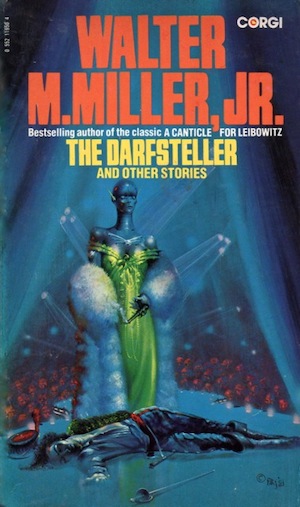
Thanks to advances in the field of robotic acting, Ryan Thornier, former star, is now Ryan Thornier, underpaid theatre janitor. True, there are many occupations not yet automated to which the old man could apply his thespian talents—salesman, politician, general—but these are beneath the former star. Only stage acting will do. But his desire to shine onstage cannot erase the fact that robotic mannikins programmed with recorded personality matrices deliver the same services as living actors, but are much cheaper and more reliable.
Ryan is very stubborn. Given even the smallest hope of reclaiming his lost place on stage, he will leap to take advantage of the opportunity…regardless of consequences.
***
“So Bright the Vision” by Clifford D. Simak (1956)
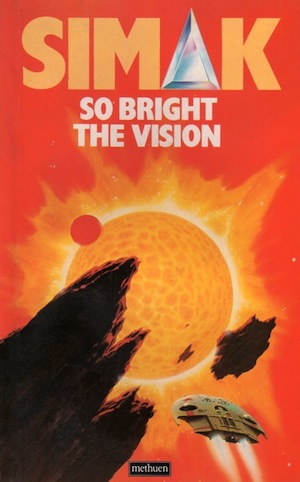
Earth has one resource no alien world can match, which is the human gift for outrageous, entertaining falsehood. Determined to fill the galactic demand for fiction, Earth maximized output by automating writing. Powerful word engines grind out story after story, thus ensuring Earth’s economic well-being.
What’s good for Earth can be mighty hard on the individual. Kemp Hart, for example, cannot afford to keep up with advances in writing machinery. His composing device is old-fashioned. Consequently, so is Hart’s output. Because his work is subpar, Hart cannot afford the cutting-edge machine that might lift him out of poverty. A man trapped in poverty can be forced to unthinkable extremes. Too bad that Kemp Hart can’t resist temptation.
***
The Silver Eggheads by Fritz Leiber (1962)
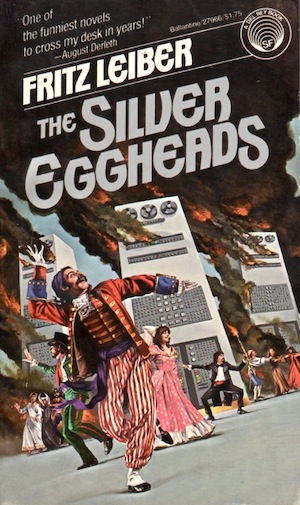
Comfortably ensconced within lurid covers enhanced with sound, moving pictures, embossing and textures—covers of which today’s publishers can only dream—the novels of tomorrow deliver to avid readers fiction perfectly suited to the reader’s tastes. How could they not? Every work is composed by wordmills, flawless fiction-generating mechanisms.
There is one tiny flaw in this utopia, which is that though they are obsolete, human writers persist. Despite featherbedding rules that give them sinecures as pointless assistants to the wordmills, writers dream of writing fiction themselves. It’s no surprise when the frustrated writers rise up and smash the wordmills. Now humans will dominate literature once more!
If only any of the rebellious writers had even the smallest inkling of how to actually write…
***
“What Song the Sirens Sang” by Charles Sheffield (1977)
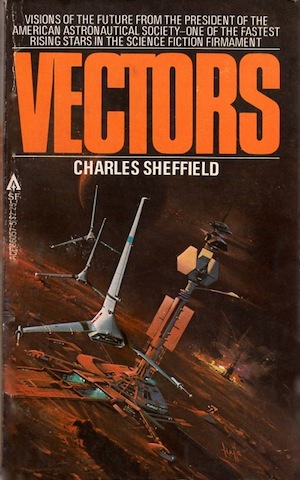
James Webster seems an unlikely demagogue, but he’s achieved a surprisingly successful political career. Veteran reporter Bill Forrest decides to take a close look at Webster. Result: consternation. Webster’s words and delivery are utterly banal, and yet the man is adored. How? Why?
Forrest discovers that Webster wields tools that make inspiration, talent, and hard work irrelevant. Whatever he says, however bland and uninspired, is irresistible. Now Forrest wonders if Webster will make human art irrelevant.
***
Don’t Bite the Sun by Tanith Lee (1976)
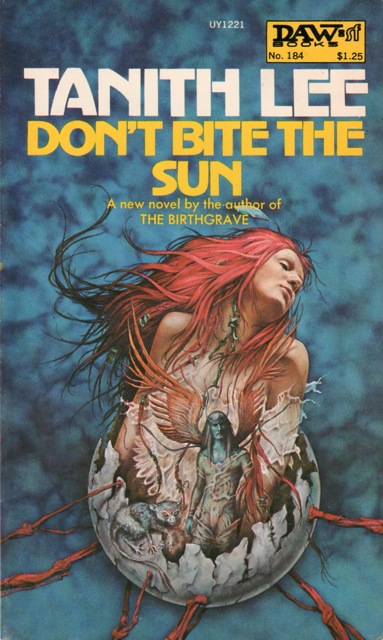
The three domed cities—Four-BAA, Four-BEE, and Four-BOO—offer their human inhabitants every experience, every bauble they might desire. Famine is unknown, appearance and gender may be altered according to personal preference, and life itself may be sustained indefinitely. Childhood is followed by socially mandated youthful debauchery, which is followed in turn by a life of staid tranquility that can be sustained for centuries… or even longer. Maintaining civilization is left to the quasi-robots.
The unnamed narrator discovers that this life does not satisfy. They do not care to fill the centuries with empty passion, boring self-indulgence, or tedious orgies. Therefore, they set out in quest of some activity that will provide meaning to their lives. It’s clear that the jobs that Older People do are pointless sinecures. Artistic expression appears to offer potential fulfillment…or it would, if the quasi-robots hadn’t automated art as well. (And if they didn’t do it better than mere humans.)
Having been denied any hope of meaningful self-expression within their cities, it is no surprise the protagonist begins to consider the wastelands outside the domed city. Here they encounter a significant impediment. The quasi-robots are willing to provide their charges with almost anything they might desire…but not freedom.
***
Perhaps other examples come to mind. (More works by women than I managed?). If so, the comments are below.
In the words of Wikipedia editor TexasAndroid, prolific book reviewer and perennial Darwin Award nominee James Davis Nicoll is of “questionable notability.” His work has appeared in Publishers Weekly and Romantic Times as well as on his own websites, James Nicoll Reviews and the Aurora finalist Young People Read Old SFF (where he is assisted by editor Karen Lofstrom and web person Adrienne L. Travis). He is a four-time finalist for the Best Fan Writer Hugo Award and is surprisingly flammable.










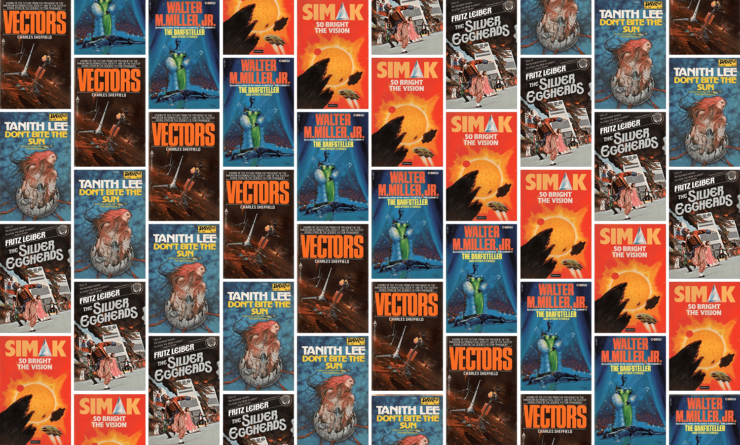
In (at least the anime expression of) Carole & Tuesday, human musicians still play and perform, but AI songwriters and composers have found the pressure points in human emotions, and become so good at churning out crying purple gorilla pablum that the titular duo are viewed as something of dancing bears for writing their own material.
Silver Metal Lover by Tanith Lee
Zima Blue.
“With These Hands” by C.M. Kornbluth (published in 1951, it almost uncannily predicts something like 3-D printing).
Asimov’s “Galley Slave”.
Rob Chilson’s short story “Brain Jag” (Analog Science Fiction / Science Fact, June 1987) featured an unusual plagiarism case. An art student used his rival’s Pocketbrain – a portable computer with a direct-to-mind interface – to lift said rival’s art style from his neural imprint. The professor called in as an expert became very fearful for the future of creativity if this particular use of Pocketbrain technology became widely known…
Julia in 1984 works to help produce automated literature for the proles.
Well, the Silver Eggheads cover is certainly…unique.
James, I am afraid that you wasted Don’t Bite The Sun on a list that it is really only tangentially related to. The quasi-robot produced art was really a side-line to the story. For that matter, the protagonist’s art sounded substantially superior to the QR art; it just would have made people uncomfortable or caused them to think in sub-optimal ways (from the QR point of view).
I would suggest one of the stories from Stanislav Lem’s Cyberiad, which features a computerized poet that is so good that all other poets become obsolete. Lem noted that, in fact, only good poets would recognize that the machine was better, leading them to attempt suicide or beat up the machine’s creator; bad poets were supremely confident that their output was excellent, and so were unaffected by the machine.
Robert Silverberg’s “The Macauley Circuit” is about cybernetic musical composition and (in essence) whether creativity can be coded. Apologies for linking to Amazon, but this:
https://www.amazon.com/MACAULEY-CIRCUIT-CLASSIC-SCIENCE-FICTION-ebook/dp/B00C3MNG4A
…has some words of Silverberg[or a really good simulation of him]’s about the story.
John Sladek’s hyper-dark comedy Tik-Tok (1983) is narrated by a robot who has simultaneously discovered 1. that he enjoys painting and is the first robot to have developed real creative talent, and 2. that his “asimov circuits” are defective or imaginary and so he is free from all social or ethical constraint, and enjoys murdering people. Whether there’s a connection between those things, as some of the Romantics suggested, Sladek leaves as an exercise for the reader.
Humans apparently are not the only animal that produces art, if that was implied. See the Bower Bird
Fascinating that while theatrical acting has been automated, the janitorial work has not been.
(Although one could argue that this is not that different from current-day theaters, in the majority of which the entertainment is provided by robotic electromagnetic-ray projectors using data provided by centralized external agencies, but little of the other work has been roboticized.)
In “Count Zero”, William Gibson has an AI construct a series of Cornell boxes that attract attention in the world because of the ‘biosoft’ material used in one of them. This was my introduction to the collage boxes of Joseph Cornell. Gibson has since written about his attraction to Cornell boxes and has compared his novels to a series of those boxes. His short story “Thirteen Views of a Cardboard City” appears to be descriptions of thirteen different Cornell boxes.
From Poul Anderson’s Quixote and the Windmill:
“Great universe!” he breathed. “Pete . . . Pete . . . look, it’s the robot! It’s the robot!”
“Huh?” Borklin twisted around, trying to focus his eyes out the door. “Whazzat?”
“The robot—you’ve heard of it, man.” Brady’s soddenness was gone in a sudden shivering intensity. His voice was like metal. “They built him three years ago at Cybernetics Lab. Manlike, with a volitional, non-specialized brain—manlike, but more than man!”
“Yeah . . . yeah, I heard.” Borklin looked out and saw the great shining form striding across the gardens, bound on some unknown journey that took him past the tavern. “They were testing him. But he’s been running around loose for a year or so now— Wonder where he’s going?”
“I don’t know.” As if hypnotized, Brady looked after the mighty thing. “I don’t know—” His voice trailed off, then suddenly he stood up and then lashed out: “But we’ll find out! Come on, Pete!”
“Where . . . huh . . . why—” Borklin rose slowly, fumbling through his own bewilderment. “What do you mean?”
“Don’t you see, don’t you see? It’s the robot—the man after man—all that man is, and how much more we don’t even imagine. Pete, the machines have been replacing men, here, there, everywhere. This is the machine that will replace man!”
Isaac Asimov had an artistic robot in short story “Yvtug Irefr”. I put the title in ROT13 code because I think it’s meant to be a surprise that the artist is a robot.
Janes Schmitz’s “Telzey Amberdon” encounters artificially created actors. Since she can read their minds, they do have minds… but Isaac Asimov produced (fictional) telepathic robots… and my take on Philip K. Dick stories I’ve seen involving “androids”, meat or mechanical, is that the nature of their personhood is less important to the author than how society respects it or doesn’t, but I don’t remember when art came up.
When I’ve seen actual attempts at creative “computer art”, I haven’t been much impressed, but it’s not like I am Leonardo DiCaprio in my spare time, either.
Asimov’s ‘Someday’ 1956, is a good one too.
If we’re including the performing arts, “Remake” by Connie Willis. Once it has become possible to digitally re-create movie actors and actresses from the past and use them to make new movies or remake old ones, “live” actors have become obsolete.
“Thing of Beauty” by Damon Knight plays an art machine from the future for laughs.
A huge machine is mistakenly delivered to a man. The instruction manual is all in a foreign language, so he starts playing with the machine. It makes drawings. Really good drawings. The man starts selling the drawings, claiming he drew them himself. Eventually the machine’s output starts to degrade; meanwhile he has some words from the instruction manual translated (they turn out to be Swedish). He’s been misusing the machine, using up its pattern memory by not erasing the art after it’s finished. The final artwork is described in terms of lines and loops — but it’s a hand held upward with thumb to nose.
@18: Not precisely what you mean, but I think it’s a subplot in Arthur C. Clarke’s “The Ghost from the Grand Banks” (i.e. the Titanic) that old films are being digitally altered to remove smoking. But by now you can probably re-shoot the whole thing in virtual reality.
Many episodes of British TV sci fi “Doctor Who” were discarded, but in some cases were audio recorded by viewers, and are being “restored” as animation – not as live action though. There have also been live remakes.
https://tardis.fandom.com/wiki/Animated_episode
@@.-@: I used most of a roll of film (31 years ago…) taking pictures of the Orpheus fountain in Stockholm, thanks to that story. (Don’t know whether it was moved, or duplicated, or misplaced in Copenhagen by Kornbluth.)
@13: Name actors get higher salaries than janitors. Which robotic replacement will save you more? IIRC, the story also suggests that there can be more than one robot copy of a good performer, which would reduce the per-unit cost.
@18: IIRC, the point of the story was that he hit what turns out to be ERASE after each piece of art is printed, depleting the store of images. You just know the machine was programmed by a serious coder; who else would have buried a snook in memory, so that it would be the last thing a careless user would see?
@21: I just reread it on archive.org, and it still seems ambiguous to me, but I guess you could be right.
The titular character in William Gibson’s Idoru is a quasi-AI software entity created to be a Japanese pop star.